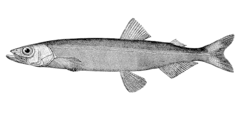Capelin
|
|
| Capelin | ||||||||||||||
|---|---|---|---|---|---|---|---|---|---|---|---|---|---|---|
| Capelin | ||||||||||||||
| Scientific classification | ||||||||||||||
| ||||||||||||||
| Binomial name | ||||||||||||||
| ''Mallotus villosus'' Müller, 1776 |
- This article is about the fish. For the plant genus, see Mallotus (plant).
The capelin (Mallotus villosus Müller 1776) is a small fish of the smelt family found in the Arctic Ocean in large quantities. In summer, it grazes on dense swarms of plankton at the edge of the ice shelf. Larger capelin also eats a great deal of krill and other crustaceans. Whales, seals, cod and seabirds all prey on capelin in particular during the spawning season of the capelin while it migrates southwards. Capelin spawns at the age of 2-6 years, and has an extremely high mortality rate after spawning, for males close to 100% mortality.
Males reach 20 cm in length, while females are up to 25 cm long. They are olive-colored dorsally, shading to silver on sides and bottom.
In years with large quantities of herring in the Barents Sea, capelin seems to be heavily affected. Probably both food competition and herring feeding on capelin larvae lead to collapses in the capelin stock.
Commercially capelin is used for fish meal and oil industry products, but is also appreciated as food. Capelin roe is considered as a high value product, particularly in Japan.
Capelin is essential as the key food of the Atlantic cod. The North-East Atlantic Cod and Capelin fisheries therefore are managed by a multi-species approach developed by the main resource owners Norway and Russia.de:Lodde no:Lodde ru:Мойва

